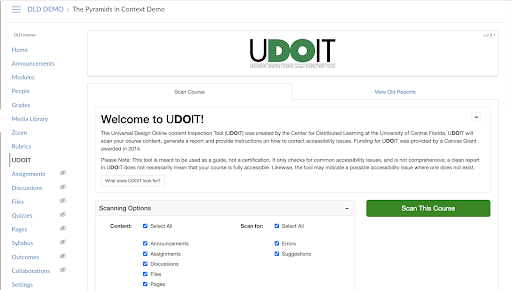Accessibility is “the extent to which an experience, product, or space can be utilized by anyone” (Gunawardena, Frechette & Layne, 2018, p. 278). As more and more courses are taught in online environments, many have shared how vital it is for digital learning environments to be as accessible as possible.
All institutions of higher learning in the United States are required by law to create accessible learning environments. The Americans with Disabilities Act of 1990 (amended in 2008) prohibits discrimination against, and mandates reasonable accommodation for, persons with disabilities. Additionally, the Rehabilitation Act of 1973, Sections 504 and 508, makes it illegal to exclude or discriminate against qualified individuals from programs receiving federal aid. In both cases, discrimination includes inaccessible digital content. Underscoring this legal mandate, Brown University’s DIAP Phase II expresses a commitment “to ensure an equitable experience for individuals with disabilities across all major web and technology platforms and experiences” (p. 12).
Beyond satisfying legal requirements, a commitment to accessibility has important pedagogical benefits. Accommodating students with disabilities or with different technology needs helps create a more inclusive learning environment in general and enables all students' full engagement with course materials. Video captions and audio transcripts, for example, can help not only students who cannot hear the content, but also those who prefer to study in quiet spaces or students who speak primary languages other than English. Designing for accessibility means designing for all. (This is one of the tenets of Universal Design for Learning, a helpful framework for optimizing student learning.)
However, national studies suggest that it can be challenging for instructors to know where to start (Shinohara, Kawas, Ko, & Ladner, 2018). Fortunately, Brown instructors have access to a new Canvas accessibility tool called UDOIT (Universal Design Online content Inspection Tool).
“It was a bit overwhelming at first […] but I really appreciated how easy UDOIT made it to find and, especially, to fix the issues. It did not take long to get the hang of it, and felt like a worthy investment of time to make my Canvas site more accessible for all of my students.” - Tara E Nummedal, Professor of History and Italian Studies
What Is UDOIT?
UDOIT helps instructors to fix common digital accessibility errors and develop more inclusive and accessible learning environments. The Canvas tool enables instructors to identify accessibility issues in their Canvas course content and provides recommendations for resolution. Examples of accessibility fixes supported by UDOIT include improving color contrast, adding alternative text for images, and checking for video captions.

The UDOIT Pilot
In Spring Term 2021, Digital Learning and Design (DLD, within the Sheridan Center) piloted UDOIT with 12 faculty participants, recruited from a Today at Brown announcement reading, “Improve Your Course in Canvas.” The participants received training on how to use UDOIT and correct the accessibility issues in their courses. A survey deployed afterwards revealed that participants found such training support helpful. Moreover, after using UDOIT, all respondents felt more confident addressing accessibility issues, and would not only use the tool in the future, but recommend it to colleagues.
"The tool was really great for quickly identifying and fixing run-of-the-mill errors, such as image alt text. I certainly felt like I was more productive with the tool as it cut out the time loading each page and digging for each error.” - George Daccache (‘21), former Instructional Design Assistant, Digital Learning and Design
Next Steps
To enable UDOIT as an instructor, TA, UTA, GTA, or designer in Canvas, open Settings in your course, then go to the Navigation tab and find UDOIT in the list of hidden navigation items. Drag and drop UDOIT to the list of navigation items or use the Enable Tool function. Brown instructors who would like to learn more, or get help resolving any issues identified by UDOIT, can email [email protected], set up a 1:1 UDOIT consult, or review Brown’s UDOIT getting started guides. Brown also offers a general guide on digital inclusion and accessible learning design and has recently adopted a tool for accessible document conversion called SensusAccess.
As distance education scholars note: “Ensuring accessibility requires viewing the organization through the eyes of prospective learners, identifying barriers as they perceive them, [and] developing strategies to minimize or eliminate barriers” (Tait and O’Rourke, 2014, p. 57). Digital accessibility is a feature that benefits all learners and educators, and thus brings institutions of education ever closer to their most democratic and inclusive aspirations and goals.
To subscribe to the Sheridan Center newsletter, please visit the Sheridan Center website. Do you or your students have additional strategies for improving the accessibility of digital learning? We would love to hear from you at [email protected].
References
Gunawardena, C., Frechette, C. & Layne, L. (2018). Culturally inclusive instructional design: A framework and guide to building online wisdom communities. Routledge.
Shinohara, K., Kawas, S., Ko, A. J., & Ladner, R. E. (2018). Who teaches accessibility? A survey of US computing faculty. In Proceedings of the 49th ACM Technical Symposium on Computer Science Education, 197-202.
Tait, A., & O’Rourke, J. (2014). Internationalization and concepts of social justice: What is to be done? In O. Zawacki-Richter & T. Anderson (Eds.), Online distance education: Towards a research agenda. Edmonton, Canada: Athabasca University Press.
Thank you to Juana L. De Los Santos, Assistant Vice President of Equal Opportunity and Diversity at Brown University, for feedback on this text.
